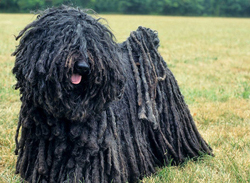Pulis are dogs of medium size with wavy or curly coats that clump together to form wooly cords. These cords help protect the breed was harsh weather. The coat comes in black, white, and gray, and it is profuse on all parts of the breed's body. The outer coat is curly or wavy, and the undercoat is dense, wooly, and soft. These dogs have large, dark, almond-shaped eyes and hanging, V-shaped ears. Their nose is black. Pulis measure 16 to 17 inches tall at the shoulder.
Pulis are highly adaptable and adjust easily to new people and situations.
Highly intelligent and adaptable dogs, Pulis have a great sense of humor and make excellent companion animals for families. They enjoy rural environments, but do well in most living situations, and they love spending time with their human family members. These dogs need plenty of exercise, but they are generally well behaved. Pulis tend to be devoted and protective, and some are suspicious of unfamiliar people and animals.
Although a number of dog breeds have corded coats, Pulis are unique. The breed's coat is tufted during early life, and when the undercoat begins to grow out, it becomes tangled with the outer coat and forms cords.
Busy, curious, and smart, Pulis are fun companions for active people. They are affectionate and family-oriented and do well in homes with children. These dogs are also protective and suspicious and make good watchdogs. They get along well with other pets, although they may be aggressive toward dogs they do not know.
Pulis are highly adaptable and adjust easily to new people and situations. They do well in most types of living environments, although they need daily exercise in the form of long walks, jogs, and lively training sessions. Pulis are not usually a good choice for small apartments due to their exercise needs.
When outdoors, Pulis must be kept in a securely fenced yard or walked on a leash. These dogs have been known to chase small animals and may run after cars on the street. Channeling their excess energy into dog sports and other productive outlets is beneficial. These dogs do well in obedience, herding, agility, tracking, and other sports.
Pulis are a generally healthy breed and are not known to suffer from many serious genetic diseases or other health problems. Of course, this does not guarantee that any individual dog will be free of illness. For the best chance at obtaining a healthy puppy, it's important to adopt or purchase one of these dogs from a reputable source.
Common health issues seen in Pulis include hearing problems, progressive retinal atrophy and other eye problems, and congenital hip dysplasia. Obesity may occur if the breed is overfed or not given adequate opportunity to exercise. Obesity in dogs increases the risk of heart disease, arthritis, diabetes, certain cancers, and other problems.
Routine veterinary checkups, timely vaccinations, a nutritious diet, and daily exercise help ensure Pulis live a long and active life.
Pulis are very intelligent dogs that are capable of both learning and teaching tricks. These dogs respond very well to firm, consistent training methods and positive reinforcement, such as praise, play, and food rewards. Patience is a necessity when it comes to training this breed; Pulis have a tendency to be very stubborn.
Like other dogs, Puli puppies like to chew. Other negative behaviors may also reach problem levels, especially without early training. Allowing these dogs to become bored or lonely increases the likelihood they will act out through destructiveness.
Socialization starting very early in life can help these dogs grow into confident and tolerant adults that know when it is appropriate to be fearful and when it is not. Puppy kindergarten is a good first step, and regular trips to the dog park and to neighborhood businesses are helpful later in life.
Grooming a Puli takes a bit of time and experience. The breed's non-shedding coat can be brushed regularly or left to form cords. Brushing should be done at least every other day to prevent tangling and mats and to remove debris and dirt from the coat. If corded, the cords must be manually separated to prevent matting, which can suffocate the Puli's skin and cause irritation.
Bathing is a time-consuming process that should only be done when needed. It can take as long as 24 hours for the Puli's coat to dry. Towel drying should be combined with an electric hair dryer to speed up the process. Otherwise, the cords may begin to smell and mildew. Keeping the hair around the mouth trimmed will cut down on odor.
The nails need clipping every couple of weeks, or more often if they start clicking on the floor, and the teeth need brushing daily to prevent tooth decay, bad breath, and gum disease. Weekly ear cleanings will remove excess ear wax; signs of ear infection should be reported to a veterinarian right away.
Pulis have been herding flocks in Hungary for 1,000 or more years. The breed's ancestors were likely introduced to the area by Magyar tribes around the 9th century. The dogs were excellent and agile sheep herders and were prized for their abilities.
After Hungary was decimated by invaders during the 1500s, animals from Western Europe helped repopulate the country. The resulting interbreeding nearly wiped out the breed by the 17th century, but Pulis were revived in 1912. A breed standard was created in 1915.
In 1935, several Pulis were imported to America by the U.S. Department of Agriculture in an attempt to improve American herding dogs. This effort was quickly thwarted by war, but it functioned to increase awareness and fondness for the breed. Today, these dogs are moderately popular companion animals in the United States.
In 1936, the American Kennel Club officially recognized the Puli.

